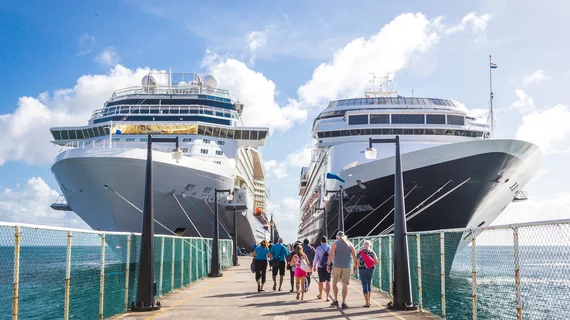‘Maritime telemedicine’: Radiologists capitalize on cruise industry’s exploding popularity
The cruise industry has exploded in popularity in recent years, with some 24 million passengers at sea for days aboard luxury ships, according to one estimate. Medical emergencies can often arise while adrift, but travel companies typically do not deploy radiologists in this process.
Wanting to fill this care gap, researchers from one German hospital recently tested out the use of a 24/7 teleradiology program. The pilot involved a mobile radiography unit, with docs transmitting images back to onshore imaging experts for quick interpretation, according to their study, published Jan. 28 in the American Journal of Roentgenology.
After testing the program out for two months on a single ship, experts at the University Hospital Hamburg-Eppendorf have expanded it to four more boats. Time will tell whether this model sustains and spreads in this burgeoning industry, they added.
“Our pilot study showed that implementation of a 24-hour teleradiology service is possible in the cruise industry,” concluded Frank Oliver Henes, with the hospital’s Department of Diagnostic and Interventional Radiology, and colleagues. “This is a complex issue that involves politics, differing standards of care, and differing sets of laws and regulations,” the team added. “The future will show the point to which the cruise industry will welcome advisory support from teleradiology partners.”
Previous studies have found that about 4% of cruise ship passengers typically consult onboard medical services, and upward of 12% experience a serious situation while at sea. Development of such “maritime telemedicine” has been limited by technology, but new communication channels such as satellite internet have busted this barrier.
Henes and colleagues tested their program between February and March of 2017, on a ship hosting 2,500 passengers. Radiographs were transmitted by satellite to a tertiary hospital on shore by using a secure virtual private network. When received, the images were automatically integrated into the PACS and interpreted by radiologists. Reports were then shipped back to sea through the same private network, according to the study. Back at the boat, the medical staff included two doctors, two nurses and a medical assistant.
During the two-month study, clinicians successfully transmitted all 75 images from 47 patients. About 75% of the studies were skeletal radiographs, while the other 25% were of the chest. Turnaround time averaged about 30 minutes the majority of the time, with a few sparse delays due to “technical and organizational issues” at the hospital.
Henes et al. noted that future studies are needed to determine the impact teleradiology had on the cruise ship-based physicians’ decision-making. But at this stage, they see it as adding value to imaging practice.
“Teleradiology may have advantages for cruise ship companies by minimizing unnecessary medical evacuations and diversion of ships to seek medical assistance,” the team concluded.

